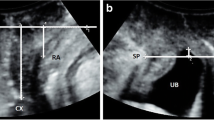Abstract
Introduction and hypothesis
There is no agreed assessment tool for physiotherapists treating pelvic organ prolapse. This study hypothesised that pelvic organ prolapse quantification (POP-Q) assessment was a feasible measure for use by physiotherapists and tested inter- and intra-rater agreement.
Methods
Six physiotherapists and two gynaecologists participated. Women were recruited from uro/gynaecology clinics. Two POP-Q examinations were performed at the first clinic (gynaecologist, physiotherapist 1) and 1 week later (physiotherapist 1, physiotherapist 2). The examination was timed and women completed a short questionnaire. Using weighted kappa, agreement of POP-Q stage was assessed.
Results
Forty-five women were recruited (median age 59, range 32–87 years). Agreement between gynaecologist and physiotherapist was substantial (weighted kappa = 0.63). Weighted kappa was 0.67 for inter-rater agreement between two different physiotherapists and 0.71 for intra-rater reliability for the same physiotherapist. Examination time was significantly shorter (difference 53 ± 73 s, p < 0.001) for gynaecologists. Participants found the examination acceptable.
Conclusions
POP-Q is a feasible and reliable outcome measure for physiotherapists to use.

Similar content being viewed by others
References
Hagen S, Stark D, Cattermole D (2004) A United Kingdom-wide survey of physiotherapy practice in the treatment of pelvic organ prolapse. Physiotherapy 90:19–26
Bump RC, Mattiason A, Bo K, Brubaker LP, DeLancey JOL, Klarskov P, Shull BL, Smith ARB (1996) The standardization of terminology of female pelvic organ prolapse and pelvic floor dysfunction. Am J Obstet Gynecol 175:10–17
Hall AF, Theofrastus JP, Cundiff GW, Harris RL, Hamilton LF, Swift SE, Bump RC (1996) Interobserver and intraobserver reliability of the proposed International Continence Society, Society of Gynecologic Surgeons, and American Urogynecologic Society pelvic organ prolapse classification system. Am J Obstet Gynecol 175:1467–1471
Kobak WH, Rosenberger K, Walters MD (1996) Interobserver variation in the assessment of pelvic organ prolapse. Int Urogynecol J 7:121–124
Visco AG, Wei JT, McClure LA, Handa VL, Nygaard IE (2003) Effects of examination technique modifications on pelvic organ prolapse quantification (POP-Q) results. Int Urogynecol J 14:136–140
Cohen J (1968) Weighted kappa: nominal scale agreement with provision for scaled disagreement or partial credit. Psychol Bull 70:213–220
Landis JR, Koch GG (1977) The measurement of observer agreement for categorical data. Biometrics 33:159–174
Hagen S, Stark D, Maher C, Adams E (2004) Conservative management of pelvic organ prolapse. The Cochrane Library, Issue 2. Wiley, Chichester
Acknowledgements
Staff who provided the intervention: Angela Davies, Chris Hardwick, Julie Lang, Kate Lough, Karen McCulloch, Christine McFadden, June McGourty, Denise McKenzie and Stewart Pringle.
Conflicts of interest
The authors declare the following for research or advisory work. Mohamed Abdel-Fattah: Astellas and Coloplast.
Funding
This study was funded by the Physiotherapy Research Foundation and the CSP Charitable Trust [PRF/05/3]. There is no conflict of interest.
Author information
Authors and Affiliations
Corresponding author
Rights and permissions
About this article
Cite this article
Stark, D., Dall, P., Abdel-Fattah, M. et al. Feasibility, inter- and intra-rater reliability of physiotherapists measuring prolapse using the pelvic organ prolapse quantification system. Int Urogynecol J 21, 651–656 (2010). https://doi.org/10.1007/s00192-009-1089-1
Received:
Accepted:
Published:
Issue Date:
DOI: https://doi.org/10.1007/s00192-009-1089-1




